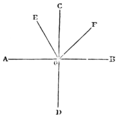Encyclopædia Britannica, Ninth Edition/Angle
ANGLE, a term employed in different senses, the most common and simplest use of it—to which all the rest may be referred, and by which they may be explained—being to indicate the inclination of two straight lines to each other. Suppose O F in the figure to turn about O from the position O B towards O C, like the opening out of the legs of a pair of compasses, the angle formed by O B and O F, which is distinguished as the angle B O F, measures the extent or degree 

of the turning or opening, being of course entirely inde pendent of the length of the lines. The ordinary method of measuring angles is based on the division of the circum ference of a circle into 360 equal parts, called degrees, the angles formed by lines radiating from the centre being proportional to the arcs of the circumference which the lines intercept. If O C makes equal angles with the straight line A O B, each of them is a right angle, or an angle of 90. In the figure A O E is an angle of 60, and C F and F O B are each 45 ; whence E O F is 75, E B 120, &c. By the angle curved lines make with each other is meant the rectilineal angle contained by the
tangents to the curves. See Geometry and Trigonometry.